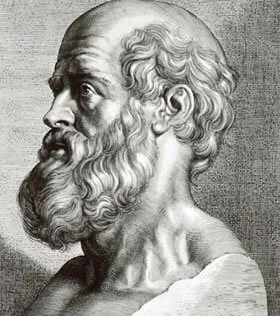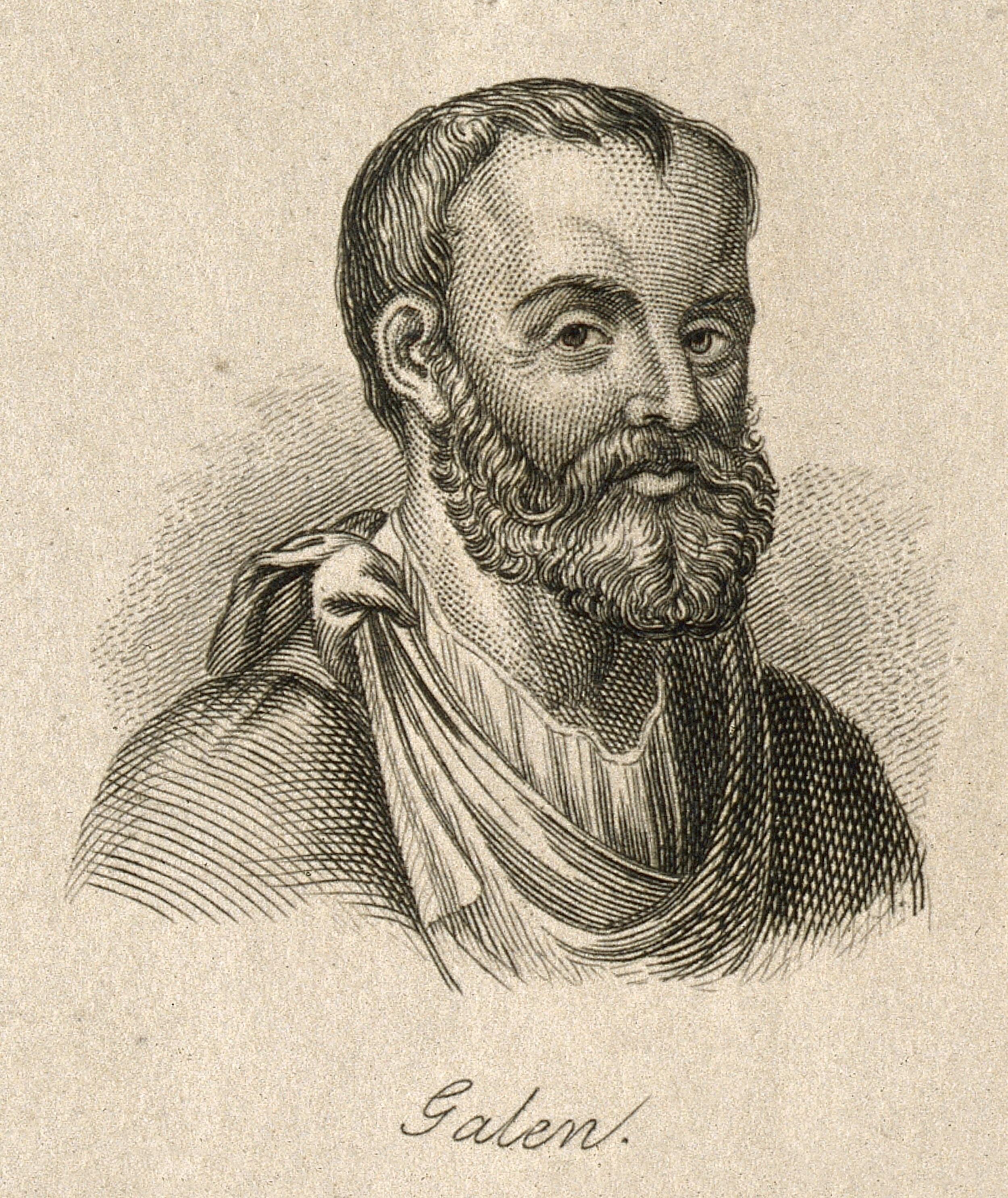The Ancient Greek Herbalists We know
The ancient Greek civilization thrived on philosophy, science, and the healing arts. From ancient texts to excavated pottery, there are countless artifacts to engage our senses. To begin our journey, we must first meet the herbalists who made history.
In the Agora
The ancient ἀγορά was a place of gathering, where the scent of delicious pastries, fresh fish, and poignant spices filled the air. It was the marketplace for new shoes, fine jewelry, and a splash of herb-infused wine. It was here where ideas and currency were exchanged and the senses filled with sights and flavors of the botanical world.
Image: Silver coin with female and silphium plant (525-480BCE), © The Trustees of the British Museum.
Asclepius
The Greek god of medicine who was the son of Apollo and Coronis. Remnants of his healing temples can be found throughout the Mediterranean with the most famous sanctuary located in Epidaurus, Greece. The visiting sick and wounded would often sleep in his sanctuaries in hopes that the god would heal them in their dreams or prescribe a healing medicinal formula.
In artwork, Asclepius often holds a rod with a sacred snake coiled around it, signifying wisdom and healing.
The botanical genus Asclepias, commonly known as milkweed, is named after him and includes the medicinal plant Asclepias tuberosa (Pleurisy Root).
Image: Roman copy of Asclepius (5th-4th century BCE), The State Hermitage Museum
Hippocrates
The "father of medicine" (460-370 BCE) was from the Greek island of Kos in the Aegean Sea and his lasting legacy, the Hippocratic Oath, continues to bind modern-day physicians to “first do no harm.”
Hippocrates was also instrumental in developing the theory of the four humours, which examined the constitutions of blood, phlegm, yellow bile, and black bile to determine the source of illness.
From the Greek word chymos or “bodily fluid,” the humours helped ancient healers explain and treat disease more effectively.
Theophrastus
The “father of botany” (c. 370 – c. 287 BCE) wrote 227 books about trees, shrubs, flowers, fruits, and animals, including Enquiry into Plants (Historia Plantarum). This nine-volume textbook helped create a new frontier in scientific botanical terminology.
Born in Lesvos, Greece and a pupil and friend of Aristotle, Theophrastus would head the Peripatetic School in Athens after Aristotle’s death for more than thirty years.
Image: Portrait of Theophrastus in Latin translation of Historia Plantarum (1483 CE), Chicago Botanic Garden.
Dioscorides
A Greek medical botanist (c. 40-90 CE) who wrote De Materia Medica, a five-volume manuscript describing approximately 600 plants for more than 1,000 traditional medicines.
His textbook, hand-copied and edited countless times, would be extensively referenced by physicians and herbalists for the following 1,500 years.
Centuries after it was written, this celebrated herbal reference would become the basis of European and Western pharmacopoeia.
Galen
A Greek physician and philosopher (129-216 CE) who worked with both gladiators and emperors. His 300 medical texts, only of which 150 survive, were referenced throughout the Mediterranean region up until the advent of modern medicine and included topics such as the four humours, dissection, pharmacology, and diet.
For an adventure with Galen, visit the digital exhibition, “The Empire’s Physician: Prosperity, Plague, and Healing in Ancient Rome,” hosted by the Institute for the Study of the Ancient World, NYU.
Image: Galen. Line engraving. Wellcome Collection
THE MAGIC TOUCH OF WOMEN WAS OFTEN HIDDEN
While women were banned from public functions, voting, and practicing medicine, they were the backbone of keeping society healthy and growing. Women taught each other the art of healing, and because women did not have the same privilege and freedoms as men, there is fewer evidence of their contribution to medicine.
Where we do find their healing touch is often in myths as sorceresses or as rebels against the establishment. Nonetheless, their medicine was just as potent, if not more, than their male counterparts.
Hygieia
The ancient Greek goddess of health and hygiene. She was the daughter and chief attendant to Asclepius, god of medicine, and along with her four sisters Panacea (Cure-All), Iaso (Recovery), Aceso (Healing), and Aglaïa (Glow of Good Health), they completed the art of healing. Although her name is the source for the word “hygiene,” her name in Greek also means "wholeness" or "soundness."
Her statue, which often shows her holding or feeding a snake, has been found at healing centers in Epidaurus, Corinth, Cos, and Pergamom, and at the entrance to the Acropolis in Athens.
It became very popular in ancient Greece to worship Hygieia during the plague which started in 400 BCE.
Today, the Hippocratic Oath continues to invoke her name: "I swear by Apollo the physician, and Asklepios, and Hygeia, and Panacea, and all the gods and goddesses, that, according to my ability and judgment, I will keep this Oath and this stipulation..."
Image: Salus, unknown artist (200-250 CE), J. Paul Getty Museum.
Circe
"Aeneas, I warn you, keep away from Circe's shores!" - Ovid, Metamorphoses, 14.245
A powerful sorceress of mythology who could hide the moon to darken the skies and destroy her enemies with poisonous juices. Circe was the daughter of Helios, the sun god, and the ocean nymph Perse, and lived on the island of Aeaea, thought to be near Sicily.
Most notable of her powers, she transformed some of Odysseus' men into pigs using magical herbs and incantations. To save himself from the same fate, Odysseus used the plant moly, a gift from Hermes, the messenger of the gods. Some research suggests the plant was snowdrop (Galanthus nivalis), which is native to the Mediterranean and contains galanthamine, an antidote to chemicals that induce a delusional state.
“At the root it was black, but its flowers were like milk. Moly, the gods call it, and it is hard for mortal men to dig. But with the gods, all things are possible.” - Homer, The Odyssey, 304-6. Translated by A.T. Murray. Loeb Classical Library, London, 1919.
Image: Circe and one of Odysseus’ transformed men, Athenian pelike (circa 5th century BCE), Staatliche Kunstsammlungen Dresden.
Agnodice
The first female physician in ancient Greece in the fourth century BCE during a time when it was forbidden for women to practice medicine. After witnessing countless women dying as a result of refusal by male doctors to treat them, Agnodice dressed as a man and enrolled in medical school. Her medical practice thrived among women who knew her secret until male authorities discovered her identity and put her on trial. A massive group of her female patients, including the wives of men who wanted her dead, defended her, decrying to her accusers:
"You men are not spouses, but enemies, since you are condemning her who discovered health for us.”
Their efforts were successful and women were finally permitted to openly study and practice medicine.
Hekate
"Torch-bearing Hekate holy daughter of great-bosomed Nyx (Night)." - Bacchylides, Fragment 1B, 5th century BCE
As the goddess of magic, witchcraft, ghosts, and crossroads, Hekate is often depicted holding twin torches of yew, which she used to guide Persephone back from the underworld every year.
Yew (Taxus baccata) is a species of evergreen tree in the conifer family. Except for the berry flesh, the entire tree is poisonous and potentially fatal. Other medicinal plants, such as dittany, mandrake, and belladonna, were also associated with Hekate’s enchanting powers.
Image: Persephone, Hermes, Hecate, and Demeter, terracotta bell-krater (440 BCE), Metropolitan Museum of Art.









